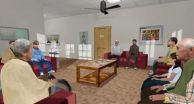(Press-News.org) A new discovery by scientists at the Universities of East Anglia and Frankfurt could make it possible in future to identify the source of banned CFCs that are probably still being released into the atmosphere.
Using mass spectrometers, the researchers analysed air samples collected in the stratosphere by balloons belonging to the French space agency, the Centre National d'Etudes Spatiales (CNES). They discovered the largest chlorine isotope enrichment ever found in nature.
CFCs were banned in most countries because of their depletion of the ozone layer. Due to their long lifetimes, their atmospheric concentrations are expected to decline only slowly. However, the observed decline is even slower than what scientists predicted. The likely reasons for this are the continued use of CFCs and emissions from old refrigerators, air conditioning units and waste disposal.
"We are particularly excited by this discovery because this is a totally new observation for atmospheric chlorine," said Johannes Laube, of the University of East Anglia's School of Environmental Sciences.
"Potentially, the technique we developed could enable us to identify remaining sources of CFCs in the atmosphere and to measure human contributions to naturally occurring ozone-depleting gases."
The measurements were obtained from samples brought back by the stratospheric balloons, but the research group has now started experiments in a laboratory where they replicate the reactions in the stratosphere.
"We try to measure the isotope effect in our laboratory in simulated stratospheric conditions," says Dr Jan Kaiser, also of the School of Environmental Sciences. "We do need to do more method development work and gather additional information before we can identify the fingerprint of the isotope in this way, but this discovery opens the door to that possibility."
INFORMATION:
Their findings are published in this week's Science. 'Chlorine isotope fractionation in the stratosphere' was authored by J. C. Laube, J. Kaiser, W. T. Sturges, H. Bönisch and A. Engel
New discovery could pave the way for identification of rogue CFC release
2010-09-04
ELSE PRESS RELEASES FROM THIS DATE:
16.6 million small business employees could benefit from ACA provisions starting this year
2010-09-04
New York, NY, September 2, 2010—16.6 million small business employees work in firms that will be eligible for tax credits under the Affordable Care Act (ACA), according to a new Commonwealth Fund report. The credits, designed to offset health insurance premium costs and help small businesses afford and maintain health insurance, are available in taxable years beginning in 2010. Researchers estimate that by 2013, 3.4 million workers may work in firms that take advantage of the tax credit. The tax credits increase in value in 2014, from up to 35 percent of the employer's ...
Hubble observations of supernova reveal composition of 'star guts' pouring out
2010-09-04
Observations made with NASA's newly refurbished Hubble Space Telescope of a nearby supernova are allowing astronomers to measure the velocity and composition of "star guts" being ejected into space following the explosion, according to a new study led by the University of Colorado at Boulder.
The team detected significant brightening of the emissions from Supernova 1987A, which were consistent with some theoretical predictions about how supernovae interact with their immediate galactic environment. Discovered in 1987, Supernova 1987A is the closest exploding star to Earth ...
Scientists discover the mechanisms and function of a type of mysterious immune cell
2010-09-04
LA JOLLA, CA – August 31, 2010 –– In two closely related studies, two teams of Scripps Research Institute scientists have discovered the underlying mechanisms that activate a type of immune cell in the skin and other organs. The findings may lead to the development of new therapies to treat inflammation, wounds, asthma, and malignant tumors.
The results of the two companion studies were published in the September 3, 2010 issue of the prestigious journal Science. Together, the new research sheds light on γδ (pronounced "gamma delta") T cells, an immune cell found ...
Protecting the lungs against 'collateral damage' from the immune system
2010-09-04
A study published today in the journal Science shows how our bodies try to minimise potential 'collateral damage' caused by our immune system when fighting infection. The research may also provide new clues to why cigarette smoke is a significant risk factor for developing diseases of the lung such as chronic bronchitis and emphysema.
When bacteria or viruses enter the body, our immune system fights back to neutralise any danger. One of the key 'soldiers' working for the immune system is a particular type of cell known as a neutrophil, which releases toxic enzymes to ...
Models suggest treatments for fractures that won't heal
2010-09-04
New models, reinforced by in vivo experimentation, show why 5-10% of bone fractures don't heal properly, and how these cases may be treated to restart the healing process. Results of the model, published September 2 in the open-access journal PLoS Computational Biology, may benefit the ageing population in which the occurrence of bone fractures is expected to rise substantially in the near future.
In 5 to 10% of bone fracture cases, the healing process does not succeed in repairing the bone, which leads to the formation of delayed unions or even non-unions - fractures ...
Ants take on Goliath role in protecting trees in the savanna from elephants
2010-09-04
GAINESVILLE, Fla. --- Ants are not out of their weight class when defending trees from the appetite of nature's heavyweight, the African elephant, a new University of Florida study finds.
Columns of angered ants will crawl up into elephant trunks to repel the ravenous beasts from devouring tree cover throughout drought-plagued East African savannas, playing a potentially important role in regulating carbon sequestration in these ecosystems, said Todd Palmer, a UF biology professor and co-author of a paper being published this week in the journal Current Biology.
"It ...
Study challenges value of oxygen therapy in end-of-life care
2010-09-04
DURHAM, N.C. – Millions of patients with advanced disease in palliative care settings receive oxygen therapy to help them breathe more easily. But a new study from Duke University Medical Center says roughly half of them don't benefit from the intervention, and among those who do benefit, it doesn't make a bit of difference whether they get pure oxygen or just plain old room air – both offer equal benefit.
"Offering oxygen when patients begin experiencing shortness of breath has become standard care in many places, but the practice is not based on rigorous scientific ...
Lupus Research Institute-funded study points to increased risk for lupus in men
2010-09-04
Lupus Research Institute-funded researcher Betty Tsao, PhD, at the University of California Los Angeles has discovered that humans—males in particular—with a variant form of the immune receptor gene "Toll Like Receptor 7 (TLR7)" are at increased risk of developing the autoimmune disease systemic lupus erythematosus (lupus). This breakthrough finding offers renewed hope for developing more targeted treatments.
The powerful finding recently published in the Proceedings of the National Academy of Sciences (PNAS) represents additional strong evidence from human cells—as opposed ...
Hip dysplasia susceptibility in dogs may be underreported, according to Penn Vet comparative study
2010-09-04
VIDEO:
Dr. Gail Smith, a veterinary orthopedic surgeon, discusses the PennHIP method for diagnosing a dog's susceptibility to osteoarthritis.
Click here for more information.
PHILADELPHIA –- A study comparing a University of Pennsylvania method for evaluating a dog's susceptibility to hip dysplasia to the traditional American method has shown that 80 percent of dogs judged to be normal by the traditional method are actually at risk for developing osteoarthritis and hip dysplasia, ...
Human unconscious is transferred to virtual characters
2010-09-04
Virtual characters can behave according to actions carried out unconsciously by humans. Researchers at the University of Barcelona have created a system which measures human physiological parameters, such as respiration or heart rate, and introduces them into computer designed characters in real time.
"The ultimate aim is to develop a method which allows humans to unconsciously relate with some parts of the virtual environment more intensely than with others, and that they are encouraged only by their own physiological responses to the virtual reality shown", Christoph ...


